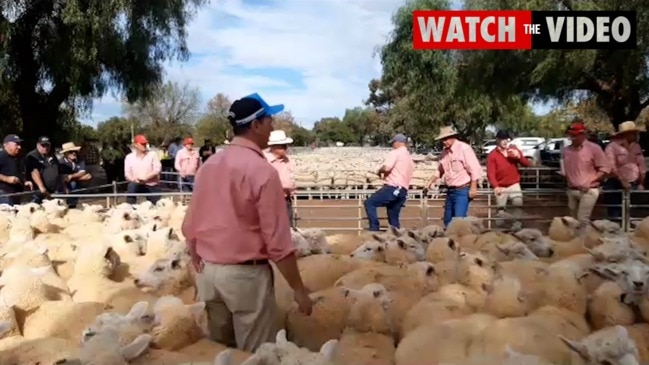Tough days at the office for livestock producers
Confidence is a big part of the livestock industry, and no one in the production chain seems to be feeling it at the moment.

Confidence is a big part of the livestock industry, and no one in the production chain seems to be feeling it at the moment, and prices are starting to melt as a consequence.
The dictionary describes ‘confidence’ as ‘the feeling or belief that one can have faith in or rely on something or someone.”
This needs to be improved on several fronts - starting at the farm gate in regards to the season and future price returns for stock and stretching through to meat sales as oddities start to appear in consumer spending and food trends.
Both the sheep and cattle markets are being affected as confidence and direction ebbs out of the market.
The standout example of confidence taking a hit was at the Deniliquin store sheep sale last week, where most scanned-in-lamb Merino sold for less than $140, with some of the older ewes struggling to make current kill value.
It was also a tough day for Merino wether lambs which sold from $20 to $100, with most sales from $30 to $70.
There was a quality component to some of the cheaper rates recorded at Deniliquin, with much of the yarding showing the effects of having been caught up in the floods and extremely wet conditions in the spring.
But it was the reaction of the small crowd which was telling, as people talked about how ‘cheap’ some of the sheep and lambs looked, but they still stood back and were reluctant to bid.
Some dry weeks without much-needed follow-up rain in many areas, and the onset of cold conditions, are once again testing producer confidence in the season as they continue to get bombarded with media coverage of a possible El Nino.
Another negative playing on people’s psyche is the lack of any price momentum for lamb heading into winter.
Saleyard data is now reflecting farmers’ lack of confidence and willingness to commit to feeding lambs, with price rates for trade and light and stock continuing to erode as supply overwhelms demand.
These are the latest price averages at saleyards, based on National Livestock Reporting Service reporting:
•Heavy lambs at 680c/kg carcass weight to be tracking 84c/kg shy of a year ago;
•Trade lambs at 636c/kg carcass weight, now 152c/kg behind last May; and
•Light lambs at 529c carcass weight, now 262c/kg cheaper than last year.
The price correction for light lambs is currently three times greater than the year-on-year price change for heavy-processing lambs.

The other indicator showing producer uncertainty is the joined ewe market, with buy-in costs now more favourable than in recent seasons.
The graph on this page shows the price trend line for scanned-in lamb first cross and Merino ewes sold on AuctionsPlus. For example, in the autumn of 2021 and 2022, when prices consistently sat above $300 (reaching a peak of $405 in January last year for crossbreds), there was only a $70 to $80 price gap between the scanned in lamb price and what a producer was receiving for a heavy prime lamb and cull ewe.
For example, in April 29021, the average scanned-in lamb crossbred ewe price on AuctionsPlus was $325, and at the time, a 30kg lamb was returning $236 and a heavy ewe $160 for a combined income of $396 ($396 - $325 = +$71).
This April, the average price of a scanned-in lamb crossbred ewe was $205, against an average of $205 for a heavy lamb and $112 for a cull ewe to equal $317, creating a better theoretical changeover of +$112. A change from $70 to $112 mightn’t seem much, but in percentage terms, it is significant and highlights how demand has started to wane for breeding stock as uncertainty over pricing and feed factors into buying decisions.
All the above examples showcase the impact of waning confidence and pressure points at the farming level.
Some interesting data from the United States this week shows how uncertainty is swirling around meat sales and gives an insight into why the cow market hasn’t rallied as expected on the back of falling American cattle kills as it comes out of drought.
US market analyst Len Steiner said meat traders in the US were becoming “increasingly nervous” by trends showing up in meat sales, including falling chicken prices at a time when they should be nearing a seasonal peak.
“The main staples for fast food restaurants are chicken breasts and lean boneless (hamburger) beef,” he wrote this week.
“Prices usually peak in late May or June and then steadily decline, but in the case of chicken breasts, the seasonal peak never arrived, and prices have been consistently trending lower.”
Mr Steiner said importers of manufacturing beef were watching these trends and becoming wary of purchasing at current prices due to questions over consumer demand and spending.
The price of grinding beef fell in the US this past week, and it was reflected in ordinary price results for saleyard cows in Australia, which averaged 246c/kg liveweight on Monday, dropping 15c/kg in the space of three trading days.
Confidence is being tested all along the livestock chain, which in turn is showing up in mixed and cheaper results for producers selling stock.




